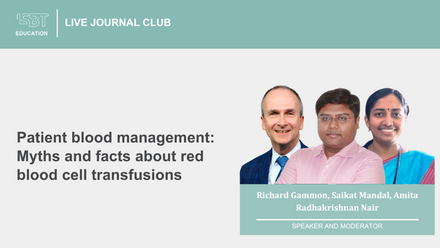The Blood Stop and Go session included the following presentations:
1. Tor Audun Hervig: Pre-Hospital Use of Blood Products
2. Saif Ali: A large multicentre evaluation of massive hemorrhage protocol performance and compliance across adult and pediatric hospitals
3. Laura Green: Massive transfusion - can we agree on a definition?
4. Sakara Hutspardol: Comparison of ROTEM and Conventional Coagulation Tests in Identifying Trauma-Induced Coagulopathy During Massive Hemorrhage Protocol
5. Helen Elizabeth Haysom: Did critically bleeding RhD negative patients receive RhD matched RBCs? Data from the Australian and New Zealand Massive Transfusion Registry
MODERATORS: Arwa Al-Riyami and Jouni Lauronen
After the presentation, there was a questions and answers session of about 5 minutes, which is also included in the recording.
Abstract
Massive transfusion–can we agree on a definition?
V Lin1,2, E Sun3, S Yau4, C Abeyakoon5, G Seamer4, S Bhopal4, H Tucker6, C Doree7, S Brunskill7, Z McQuilten2,5, S Stanworth8,9, E Wood2,5, L Green8,9,10,11
1Clinical Haematology, Royal Melbourne Hospital, Parkville
2Transfusion Research Unit, Monash University, Melbourne
3Faculty of Medicine, Dentistry, and Health Sciences, University of Melbourne, Parkville
4Faculty of Medicine, Nursing, and Health Sciences, Monash University
5Clinical Haematology, Monash Health, Clayton, Australia
6Emergency, St George's Hospital NHS Foundation Trust, London
7Systematic Review Initiative, NHS Blood and Transplant, Oxford
8NHS Blood and Transplant, London, United Kingdom
9International Collaboration for Transfusion for Transfusion Medicine Guidelines, Ottawa, Canada
10Barts Health NHS Trust
11Blizard Institute, Queen Mary University of London, London, United Kingdom
Background: Recognizing the importance of blood transfusion for improving outcomes of major bleeding, many studies use massive transfusion (MT) as an outcome measure. However, no standardised definition for MT currently exists.
Aims: As part of a collaboration to investigate an international consensus definition for MT, we performed a systematic review of the literature to identify MT definitions used in randomised control trials (RCTs).
Methods: We searched relevant databases from inception to August 2022. To be eligible for inclusion, studies had to: (1) be an RCT; (2) include adult patient population with an acquired bleeding disorder in any clinical setting who had received, or were anticipated to receive, MT; and (3) specify an MT definition. In cases where trial protocol and results were published separately, only the latter was included.
Results: 8640 references were identified, of which 19 published and 11 ongoing RCTs fulfilled our criteria, published between 1986 and 2022. Trauma (13/19) and obstetrics/gynaecology (5/11) were the most common settings for published and ongoing RCTs, respectively. We identified 15 distinct MT definitions. The most common was ≥10 units of red blood cells (RBC) in 24 h (n = 10: trauma 9/10), followed by 10 units of RBC without any defined time (trauma [2], mixed [2], orthopaedics [1], cardiothoracic surgery [1]) and others (Table 1). We identified 3 key themes: lack of other blood components/products included in MT definitions, more recent definitions moving towards fewer RBC units given over a shorter period, and more non-trauma RCTs being performed.
Summary/Conclusions: Lack of standardisation of MT definitions precludes the comparison of outcomes between trials and limits the synthesis of evidence to inform future research and guideline development. Our findings will help international transfusion/clinical communities to define key elements of MT for future use, including whether a ‘one-size-fits-all’ definition should be used across all clinical settings and whether the definition should be RBC-focussed or include other blood components/products.



















